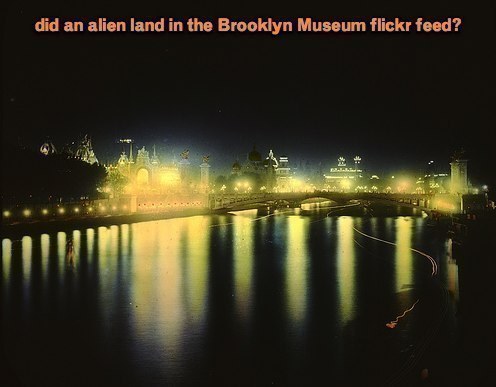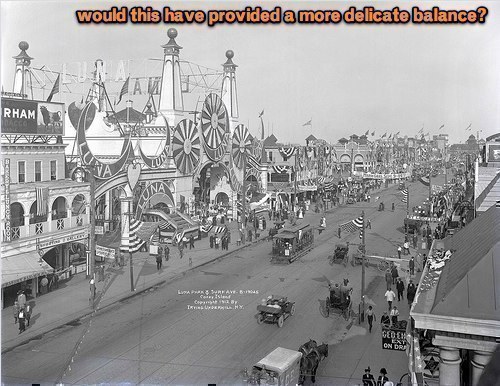Flickr Commons: A Delicate Balance
This is part two in what I think will eventually be a three part series (sorry, Tyler, I realize you are the king of the three part-er, but this requires some room). In the last post on the subject, I was exploring some of the confusion generated from our rights statement. For this post, I’ll be discussing how differences in content can shift the balance in unexpected ways.
When we established an account on Flickr back in 2006 (was it that long ago?), the idea was simple: reach out to make personal connections with our visitors and extend the visit. Our first uploads were centered around our Graffiti exhibition—document an interactive in the gallery, so visitors could see their contribution, share with others and discover how the interactive changed over time. What we found was an incredibly rich community of users who wanted to engage with us and after Graffiti we continued sharing the daily life of the institution in various ways often uploading photos of gee-whiz-behind-the-scenes. For the most part, it was kind of a small town over there – even with 1500 contacts, I could pretty definitively say I knew many of them and easily kept up with the goings-on at their feeds. Though we’d hear from people in all parts of the world, for the most part, this was a local community with many of our most active contributors living right down the street or very close by and visiting often.
Now, jump to two years later. Flickr created The Commons and joining to share our archival material seemed really natural to us, but we were firm—we didn’t want to open a separate account for these photographs. We felt (and still do today) that the content shouldn’t be split. Given the exposure Flickr gives to The Commons, it seemed as if the creation of a second Commons-only account would send the wrong message to our current Flickr community—as if this material was somehow more important than everything else and we just didn’t think that was fair to either the community or the materials to separate it. Flickr understood where we were going with this and graciously created what is now known as the “blended” account, where we could continue uploading daily life and add Commons material to the mix.
Initially, we were worried there would be confusion—would people mistake one type of content for another in a blended account? On the contrary, we’ve found most people are pretty clear on the differences and this has confirmed our general feeling that Flickr is a great place to be where people really take-in and process what is going on. That said, we’ve had some unexpected issues crop up and we wonder if it may be as a result of the type of materials we initially decided to upload to The Commons.

Paris Exposition: night view, Paris, France, 1900. Night view includes the Ponte Alexandre III. Brooklyn Museum Archives, Goodyear Archival Collection (S03_06_01_015 image 2012).
The idea was to use materials we already had on hand and, since Flickr is a global community, begin by uploading materials that were of general interest. We began by uploading shots of expositions in Paris and Chicago and images of Egypt. Two things may have happened as a result of this strategy. First, we quickly found was our small town turned into a big, booming metropolis (something I’m going to talk more about in the next post). Second, it seems as if the people engaging with The Commons materials may have different motivation than our original, more local audience. The Commons audience cares deeply about the material we uploaded, but perhaps are not as invested in who houses it. In turn, we’ve noticed that our original Flickr audience doesn’t seem to respond much to The Commons material we upload (they seem more invested in place and, therefore, the daily-life-of-the-institution photos we still publish). In hindsight, this makes a lot of sense and, as a result, the types of interaction that are happening on the account are just not as balanced as we’d like.

Irving Underhill, American, 1872-1960. Luna Park and Surf Avenue, Coney Island, 1912. Archival inkjet print. Brooklyn Museum/Brooklyn Public Library, Brooklyn Collection. mp1-1996.164.8-B19045.
If we had to do it all over again, we would not change our position regarding the need for the blended account, but I think we might have re-considered what those first Commons uploads would have been. We have a series of glass negatives that depict scenes of old Brooklyn and, looking back, I think this material might have split the difference and engaged both audiences a bit better. I’m leaning in this direction because we have seen some crossover with our Egyptian materials and this makes a lot of sense given that the museum is known for its Egyptian collection—this is content that speaks to both the Commons audience and our local visitors. Then, perhaps, slowly branching out into Paris and Chicago might have brought everyone together as we all grew.
As we pause to consider our next steps, it leaves Deirdre, Angie and me thinking about what kinds of materials to upload in the next round in the hopes that we can create a more delicate balance between these two worlds.
In the next post, I’ll be discussing challenges with the workload.

Shelley Bernstein is the former Vice Director of Digital Engagement & Technology at the Brooklyn Museum where she spearheaded digital projects with public participation at their center. In the most recent example—ASK Brooklyn Museum—visitors ask questions using their mobile devices and experts answer in real time. She organized three award-winning projects—Click! A Crowd-Curated Exhibition, Split Second: Indian Paintings, GO: a community-curated open studio project—which enabled the public to participate in the exhibition process.
Shelley was named one of the 40 Under 40 in Crain's New York Business and her work on the Museum's digital strategy has been featured in the New York Times.
In 2016, Shelley joined the staff at the Barnes Foundation as the Deputy Director of Digital Initiatives and Chief Experience Officer.
